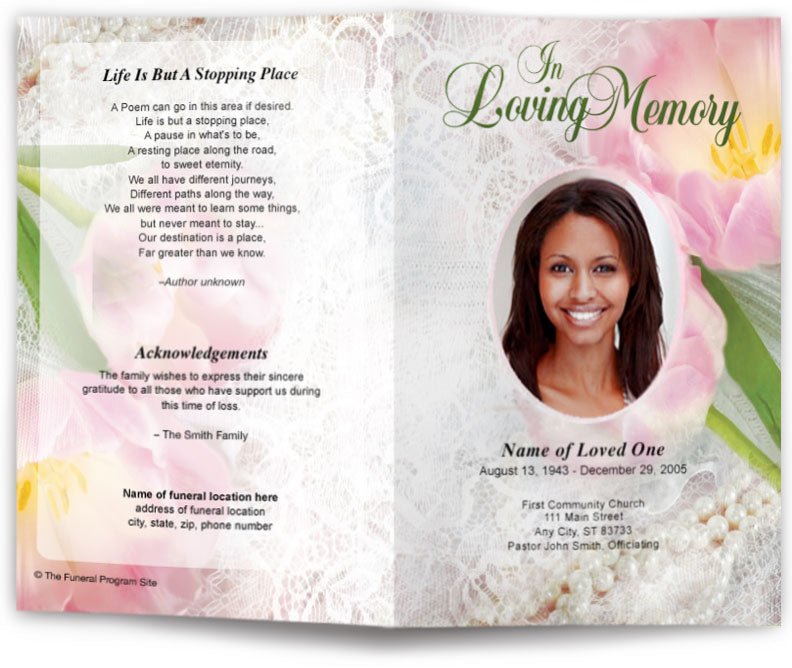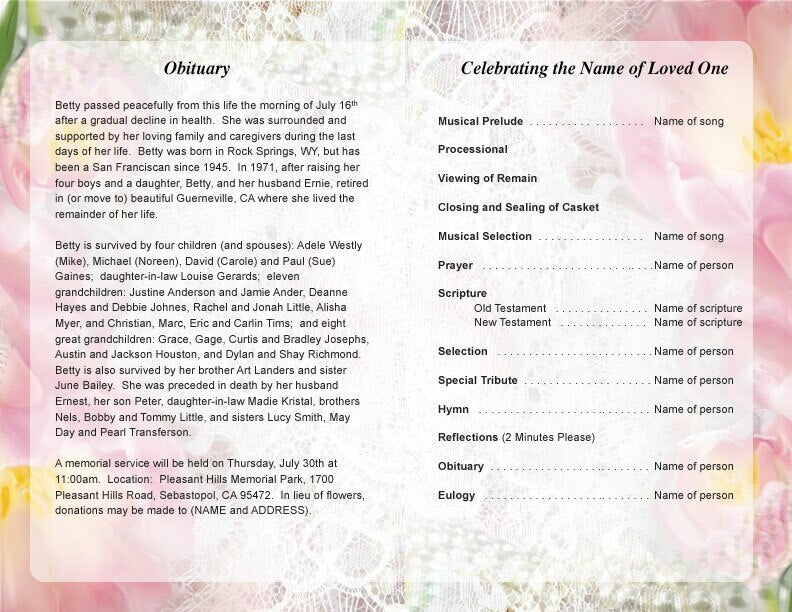Common Mistakes to Avoid When Creating a Funeral Program

Creating a funeral program is an important step in honoring and celebrating the life of a loved one. A well-crafted program serves not only as a guide for the memorial service but also as a keepsake that family and friends will treasure for years to come. However, in the midst of grief and time constraints, mistakes can easily occur. Understanding common pitfalls in the funeral program creation process can help you produce a polished, heartfelt tribute.
Neglecting to Proofread Carefully
One of the most frequent mistakes is failing to thoroughly proofread the funeral program. Grammatical errors, misspelled names, incorrect dates, or typos in scripture verses can detract from the program’s sincerity and professionalism.
How to Avoid It
-
Have multiple people review the text before printing.
-
Read the program aloud to catch errors.
-
Pay special attention to names, dates, and ceremonial details.
Using Low-Resolution Images
Including photos in the funeral program adds a personal touch, but poor-quality images can appear pixelated or blurry when printed.
How to Avoid It
-
Use high-resolution images (at least 300 DPI).
-
Scan older photos professionally if needed.
-
Preview images at full size before finalizing the design.
Choosing Inappropriate Fonts
The font style significantly impacts the program’s readability and tone. Fonts that are too ornate or casual can undermine the program's solemnity.
How to Avoid It
-
Select classic, easy-to-read fonts like Times New Roman, Garamond, or Arial.
-
Use decorative fonts sparingly and only for headings.
-
Maintain consistent font use throughout the program.
Overcrowding the Layout
Trying to include too much text or too many photos can make the program feel cluttered and difficult to read.
How to Avoid It
-
Prioritize essential content.
-
Balance text with white space for visual ease.
-
If needed, expand the program to additional pages rather than cramming content.
Omitting Important Information
Sometimes crucial details, such as the order of service, names of participants, or acknowledgment messages, are accidentally left out.
How to Avoid It
-
Create a checklist of all necessary sections.
-
Consult with family members and the officiant to confirm the service structure.
-
Review similar funeral programs for inspiration.
Choosing the Wrong Paper Type
The paper you select affects both the appearance and durability of the funeral program. Cheap, thin paper can feel insubstantial.
How to Avoid It
-
Choose heavier stock (at least 80 lb text or cover weight).
-
Opt for a matte or satin finish for an elegant, professional feel.
-
Discuss paper options with your printer if unsure.
Underestimating the Number of Copies Needed
Running out of funeral programs during the service can be disappointing for guests.
How to Avoid It
-
Estimate attendance and print at least 10-20% more programs than expected.
-
Remember that some guests may want extra copies as keepsakes.
Ignoring Cultural or Religious Traditions
If the funeral service follows specific cultural or religious practices, omitting traditional elements from the program can be seen as insensitive.
How to Avoid It
-
Consult with religious leaders or cultural advisors.
-
Research common customs for the faith or tradition.
-
Include traditional prayers, songs, or readings where appropriate.
Waiting Until the Last Minute
Designing, editing, and printing a funeral program takes time. Last-minute work often leads to mistakes and added stress.
How to Avoid It
-
Start designing as early as possible.
-
Set internal deadlines for content collection and proofing.
-
Allow extra time for unexpected changes or printer delays.
Overcomplicating the Design
An overly complicated or busy design can detract from the program's heartfelt message.
How to Avoid It
-
Keep the design clean and focused.
-
Use simple backgrounds and color schemes.
-
Let photos and text speak for themselves without excessive embellishments.
Forgetting to Credit Contributors
If friends, family members, or musicians contribute to the service, failing to acknowledge them in the program can unintentionally cause hurt feelings.
How to Avoid It
-
Include a section to thank all participants.
-
Mention musical selections and readers by name.
-
Express appreciation for the support and condolences received.
Misaligning the Order of Service
Errors in the sequence of events can cause confusion during the ceremony.
How to Avoid It
-
Confirm the order of service with the officiant.
-
List events chronologically and clearly.
-
Specify names and titles for each speaker or performer.
Not Considering Digital Distribution
In today’s digital world, some guests may not attend in person but still wish to participate.
How to Avoid It
-
Create a digital version of the funeral program (PDF).
-
Email it to remote guests or upload it to a memorial website.
-
Include links to virtual services or tributes if available.
Printing Without a Test Run
Printing all copies without first checking a proof can lead to costly mistakes.
How to Avoid It
-
Print a sample copy to inspect color, layout, and folds.
-
Adjust margins and image placement as needed.
-
Confirm everything before committing to a full print run.
Ignoring Accessibility Needs
Programs with tiny fonts or confusing layouts can be difficult for elderly guests to read.
How to Avoid It
-
Use larger font sizes (minimum 12-14 pt for body text).
-
Avoid low-contrast color combinations.
-
Ensure logical, intuitive organization.
Not Setting the Right Tone
The funeral program sets the emotional tone for the service. An overly casual or humorous tone may not suit all audiences.
How to Avoid It
-
Use language that conveys respect, comfort, and remembrance.
-
Align the tone with the family's wishes and the deceased’s personality.
-
Save lighter anecdotes for eulogies or speeches if appropriate.
Overlooking Special Keepsake Opportunities
A funeral program can be more than just an event guide; it can serve as a cherished keepsake.
How to Avoid It
-
Consider adding a favorite poem, quote, or scripture.
-
Include a photo montage or timeline of major life events.
-
Offer a bookmark or prayer card as a companion piece.
Failing to Coordinate With the Funeral Home
Some funeral homes provide assistance or have guidelines regarding printed materials.
How to Avoid It
-
Communicate early with the funeral director.
-
Verify if they offer printing services or templates.
-
Confirm any restrictions or preferences they may have.
Being Inflexible with Revisions
Sometimes last-minute changes are unavoidable, especially with input from family members.
How to Avoid It
-
Stay open to adjustments.
-
Set clear but flexible deadlines for content submissions.
-
Prepare a backup plan for quick edits if needed.
Common Mistakes to Avoid When Creating a Funeral Program Conclusion
Creating a funeral program requires care, attention to detail, and sensitivity. By avoiding these common mistakes, you can design a thoughtful and beautifully presented program that honors your loved one's memory in the best possible way. Taking the time to plan, proof, and personalize ensures that the program serves its dual purpose: guiding guests through the memorial service and offering a lasting, heartfelt tribute for years to come. Thoughtfulness in this process brings comfort not only to the immediate family but to everyone who comes together to remember, celebrate, and say goodbye.





























